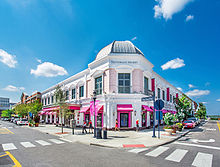Outdoor advertising

Out-of-home advertising (also referred to as OOH) is essentially any type of advertising that reaches the consumer while he or she is outside the home (or office). This is in contrast to broadcast, print, or internet advertising, which may be delivered to viewers out-of-home (e.g. via tradeshow, newsstand, hotel lobby room), but are more-often viewed in the home or office.
Out-of-home advertising, therefore, is focused on marketing to consumers when they are 'on the go' in public places, in-transit, waiting (such as in a medical office) and/or in specific commercial locations (such as in a retail venue). Billboard advertising is a traditional out-of-home advertising medium, but there has been significant growth in digital out-of-home advertising in recent years. "Ad spending on these media [in the US] soared 27% in 2006 to $1.69 billion, with accelerated 28% growth expected in 2007," according to industry analyst firm PQ Media[1].
Two of the major US industry associations in this space include the much-older Outdoor Advertising Association of America[2], which covers a broad range of traditional and digital/alternative advertising, and the more-recent Out-of-home Video Advertising Bureau[3], which is focused on video/digital networks that combine content and advertising - this is often referred to as Digital Out of Home (or DOOH)[4].
A more-recent concept that is gaining traction is that of 'place-based media' -- i.e., the concept of a media channel delivered in a specific environment. This term (sometimes also associated with the concept of 'alternative media') has been used by marketing research organizations, such as GfK[5], and media organizations covering this market segment, including MediaWeek, which has a place-based news channel[6]. Place-based media is perhaps best construed to be a segment of the larger out-of-home advertising market, but one difference is that place-based media seeks to deliver both content and advertising in a singular, sponsored 'channel,' whereas out-of-home advertising may not necessarily carry content.
Selling billboard advertising space
If a private property owner wants to sell advertising space to one of the outdoor advertising companies ('media sellers') he or she directly approaches the company. A media seller may also approach the owner of an interesting property and make a bid. If an agreement is signed, the media seller erects a structure for displaying the ads and rents out the space to the clients. The world's largest media sellers are JCDecaux, Clear Channel Outdoor, Lamar Advertising, and CBS Outdoor.
Regulations on out-of-home advertising
Different jurisdictions regulate out-of-home advertising to different degrees. In 2007, the city of Sao Paulo, Brazil, banned all billboards within the city.[1]. There are also concerns within major cities about how many billboards and other forms of outdoor advertising are not in compliance with local by-laws, such as this website's database of alleged illegal billboards in Toronto, Canada. However, in the United States, strict laws protect against the taking of property without just compensation, making a Sao Paulo-like action highly unlikely in the U.S.
See also
- Outdoor Advertising Association of America
- Advertising
- Billboard
- Digital Signage
- Point of sale display
- Flyer
- Neon signage
- Street Furniture
- Bus Advertising
- Skywriting
- Transit media
References
External links
- "The Economist" on prohibition of out-of-home advertising
- International Billboard Identity - is a database of all Indoor/Outdoor Advertisements with unique machine-readable identification number.
- Outdoor Advertising Association of America
